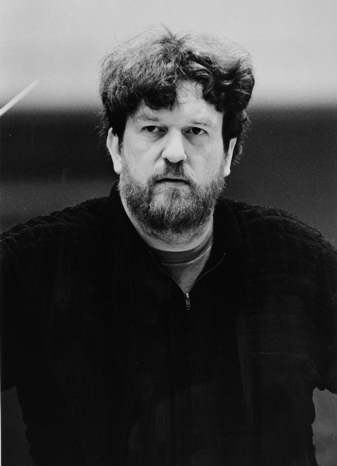Other Links
Editorial Board
- Editor - Bill Kenny
- London Editor-Melanie Eskenazi
- Founder - Len Mullenger
Google Site Search
SEEN
AND HEARD CONCERT REVIEW
Knussen,
Berg, Benjamin and Britten:
Leila Josefowicz (violin), Oliver
Knussen (conductor), BBC Symphony Orchestra, Barbican Hall,
London, 29. 3.2008 (AO)
Such a programme of riches, even by the high standards of the BBC
Symphony Orchestra! For me, the thrill was hearing two of the
best British composers in the context of two of the most important
voices of the 20th century.

Oliver Knussen - Picture © Clive Barda
Alban Berg’s Violin Concerto
is so well loved that it’s even enjoyed by many listeners who
pride themselves for despising all modern music. The joke’s on
them. The violin Concerto is pure twelve-tone serialism, further
complicated by theories based on key patterns and Berg’s
fascination with numerology. What has made the Violin Concerto
palatable is the extra musical mythology that surrounds it. It
was dedicated “to the memory of an Angel”. Manon Gropius was a
great beauty with famous family connections, so her death aged 18,
is an obvious source for romantic imagination. Certainly hearing
Leila Josefowicz play didn’t hurt as she, too, is young, blonde
and gorgeous. Clichés could pour out in torrents but that would
trivialise the essential musicality of this performance.
Josefowicz doesn’t milk the piece for crowd-pleasing pathos.
Instead, what came through in this performance was the understated
solidity of her technique. Her dialogue with the two trumpets was
cleanly balanced, as it’s an important element in the piece. In
the final Adagio, she caught the spookily high tessitura
with complete assurance, again followed by the trumpets.
Knussen’s conducting reinforced this sense of lucidity. Even when
the timpani and full strings well up in crescendo, Knussen doesn’t
overplay the romance, but keeps the stark, skeletal textures
bare. The beauty of the twelve tone system is that it can float
magical, shifting colours of its own, as if the indeterminate
tones are shimmering and diaphanous. As pure music, this is great
stuff. A pity more performances aren’t as innately attuned to its
purely artistic qualities.
Knussen had started the concert
with his own suite of interludes from Higgledy Piggledy Pop !,
a opera for children “of all ages” to use another cliché.
Listening to Berg afterwards made me appreciate the ideas in
Knussen’s own music. Both Berg and Knussen use audience-friendly
images, but their treatment in musical terms is far more
sophisticated. There’s a lightness of touch in the Knussen
extracts, underscored by sinister tension. Those staccato blasts
on the strings act like a kind of mass metronome : time is ticking
away, perhaps, or something strict and inescapable is pushing
things forward. Then, the lovely forays into exotic, almost
pentatonic colours, and the final, metallic tubular bells. The
correspondences with Berg may be unintentional, but hearing them
together made me appreciate what Knussen was writing about.
Many extra-musical things can be
written, too, about Britten’s Sinfonia da Requiem, but
again, these can distract from actually engaging with the music on
its own terms. Indeed, Britten had several contradictory ideas in
mind, so it’s not really helpful to trot out the usual homilies.
If anything, Britten made a point of being emotionally opaque.
Nonetheless, in non-vocal music Britten reveals more of himself
than perhaps he realised. That’s why Sinfonia da Requiem
moves me so much. Here are the classic Britten trademarks – ebbing
and flowing movement and keenly measured tempi. Yet there’s
something much deeper here, more personal and more painful. As
the composer remarked, “it’s rather like those awful dreams where
one parades about the place naked”. So Knussen doesn’t overdo
the external imagery, but understands the complex inner
contradictions. Different harmonies stalk each other tensely,
taking tentative steps in uneasy procession. Suddenly cymbals and
timpani burst forth, but the chilling atmosphere returns, where
flurries of clarinet, trumpet and flute soar outwards from tight,
small fragments in the orchestra. This made the very long, surging
trumpet passage seem all the more an outburst of pent-up feeling.
There are vague gestures towards Shostakovich, to Japanese harmony
and to military music, but what marked this performance was
Knussen’s shaping of the final Requiem aeternam which is
perhaps, even closer to Britten’s inner sanctum than the dramatic
Dies Irae. Here it dissolved to gradual stasis with a real
feeling of blessing and closure.
From Britten then back to
Benjamin. George Benjamin’s Dance Figures, from 2004 are a
series of nine short pieces. They don’t present dance forms as
such but rather the “essence” of dance, for they were written to
be interpreted by dancers. From that perspective, they
allow musicians to “dance” too. The pristine lines for strings in
Spell lead into a beautifully crafted ensemble. It’s
called In the Mirror because there are two reflecting
themes which interrelate and repeat themselves in a kind of
delicate canon. There’s a lively Interruption where
various different instruments perform bizarre pas de deux, then
the whole orchestra performs in mass formation at an exhilarating
high register. These whirlwind changes of mood are so vivid that
they fire up the imagination, especially when executed with
lightness of touch and good humour. One hopes that when they are
danced, the dancers will be as lively as the musicians of the
BBCSO.
Back
to Top
Cumulative Index Page
